Qi Luo
MARAG-R1: Beyond Single Retriever via Reinforcement-Learned Multi-Tool Agentic Retrieval
Oct 31, 2025Abstract:Large Language Models (LLMs) excel at reasoning and generation but are inherently limited by static pretraining data, resulting in factual inaccuracies and weak adaptability to new information. Retrieval-Augmented Generation (RAG) addresses this issue by grounding LLMs in external knowledge; However, the effectiveness of RAG critically depends on whether the model can adequately access relevant information. Existing RAG systems rely on a single retriever with fixed top-k selection, restricting access to a narrow and static subset of the corpus. As a result, this single-retriever paradigm has become the primary bottleneck for comprehensive external information acquisition, especially in tasks requiring corpus-level reasoning. To overcome this limitation, we propose MARAG-R1, a reinforcement-learned multi-tool RAG framework that enables LLMs to dynamically coordinate multiple retrieval mechanisms for broader and more precise information access. MARAG-R1 equips the model with four retrieval tools -- semantic search, keyword search, filtering, and aggregation -- and learns both how and when to use them through a two-stage training process: supervised fine-tuning followed by reinforcement learning. This design allows the model to interleave reasoning and retrieval, progressively gathering sufficient evidence for corpus-level synthesis. Experiments on GlobalQA, HotpotQA, and 2WikiMultiHopQA demonstrate that MARAG-R1 substantially outperforms strong baselines and achieves new state-of-the-art results in corpus-level reasoning tasks.
Towards Global Retrieval Augmented Generation: A Benchmark for Corpus-Level Reasoning
Oct 30, 2025Abstract:Retrieval-augmented generation (RAG) has emerged as a leading approach to reducing hallucinations in large language models (LLMs). Current RAG evaluation benchmarks primarily focus on what we call local RAG: retrieving relevant chunks from a small subset of documents to answer queries that require only localized understanding within specific text chunks. However, many real-world applications require a fundamentally different capability -- global RAG -- which involves aggregating and analyzing information across entire document collections to derive corpus-level insights (for example, "What are the top 10 most cited papers in 2023?"). In this paper, we introduce GlobalQA -- the first benchmark specifically designed to evaluate global RAG capabilities, covering four core task types: counting, extremum queries, sorting, and top-k extraction. Through systematic evaluation across different models and baselines, we find that existing RAG methods perform poorly on global tasks, with the strongest baseline achieving only 1.51 F1 score. To address these challenges, we propose GlobalRAG, a multi-tool collaborative framework that preserves structural coherence through chunk-level retrieval, incorporates LLM-driven intelligent filters to eliminate noisy documents, and integrates aggregation modules for precise symbolic computation. On the Qwen2.5-14B model, GlobalRAG achieves 6.63 F1 compared to the strongest baseline's 1.51 F1, validating the effectiveness of our method.
R3-RAG: Learning Step-by-Step Reasoning and Retrieval for LLMs via Reinforcement Learning
May 26, 2025



Abstract:Retrieval-Augmented Generation (RAG) integrates external knowledge with Large Language Models (LLMs) to enhance factual correctness and mitigate hallucination. However, dense retrievers often become the bottleneck of RAG systems due to their limited parameters compared to LLMs and their inability to perform step-by-step reasoning. While prompt-based iterative RAG attempts to address these limitations, it is constrained by human-designed workflows. To address these limitations, we propose $\textbf{R3-RAG}$, which uses $\textbf{R}$einforcement learning to make the LLM learn how to $\textbf{R}$eason and $\textbf{R}$etrieve step by step, thus retrieving comprehensive external knowledge and leading to correct answers. R3-RAG is divided into two stages. We first use cold start to make the model learn the manner of iteratively interleaving reasoning and retrieval. Then we use reinforcement learning to further harness its ability to better explore the external retrieval environment. Specifically, we propose two rewards for R3-RAG: 1) answer correctness for outcome reward, which judges whether the trajectory leads to a correct answer; 2) relevance-based document verification for process reward, encouraging the model to retrieve documents that are relevant to the user question, through which we can let the model learn how to iteratively reason and retrieve relevant documents to get the correct answer. Experimental results show that R3-RAG significantly outperforms baselines and can transfer well to different retrievers. We release R3-RAG at https://github.com/Yuan-Li-FNLP/R3-RAG.
Evaluation of Switching Technologies for Reflective and Transmissive RISs at Sub-THz Frequencies
Apr 28, 2025Abstract:For the upcoming 6G wireless networks, reconfigurable intelligent surfaces are an essential technology, enabling dynamic beamforming and signal manipulation in both reflective and transmissive modes. It is expected to utilize frequency bands in the millimeter-wave and THz, which presents unique opportunities but also significant challenges. The selection of switching technologies that can support high-frequency operation with minimal loss and high efficiency is particularly complex. In this work, we demonstrate the potential of advanced components such as Schottky diodes, memristor switches, liquid metal-based switches, phase change materials, and RF-SOI technology in RIS designs as an alternative to overcome limitations inherent in traditional technologies in D-band (110-170 GHz).
Grammar-Based Code Representation: Is It a Worthy Pursuit for LLMs?
Mar 07, 2025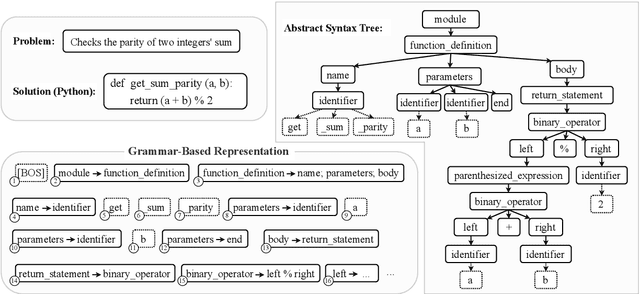
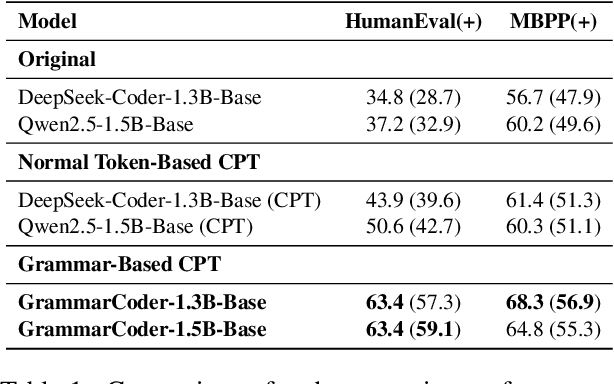
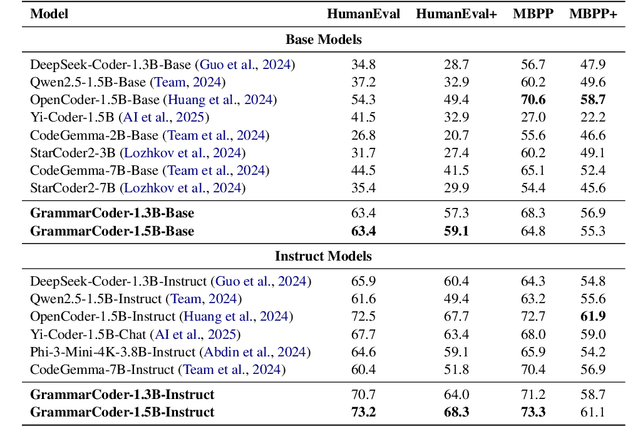
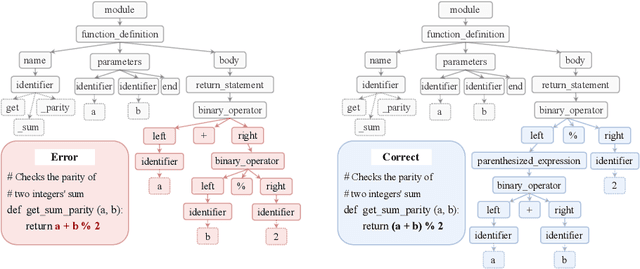
Abstract:Grammar serves as a cornerstone in programming languages and software engineering, providing frameworks to define the syntactic space and program structure. Existing research demonstrates the effectiveness of grammar-based code representations in small-scale models, showing their ability to reduce syntax errors and enhance performance. However, as language models scale to the billion level or beyond, syntax-level errors become rare, making it unclear whether grammar information still provides performance benefits. To explore this, we develop a series of billion-scale GrammarCoder models, incorporating grammar rules in the code generation process. Experiments on HumanEval (+) and MBPP (+) demonstrate a notable improvement in code generation accuracy. Further analysis shows that grammar-based representations enhance LLMs' ability to discern subtle code differences, reducing semantic errors caused by minor variations. These findings suggest that grammar-based code representations remain valuable even in billion-scale models, not only by maintaining syntax correctness but also by improving semantic differentiation.
MugenNet: A Novel Combined Convolution Neural Network and Transformer Network with its Application for Colonic Polyp Image Segmentation
Mar 31, 2024Abstract:Biomedical image segmentation is a very important part in disease diagnosis. The term "colonic polyps" refers to polypoid lesions that occur on the surface of the colonic mucosa within the intestinal lumen. In clinical practice, early detection of polyps is conducted through colonoscopy examinations and biomedical image processing. Therefore, the accurate polyp image segmentation is of great significance in colonoscopy examinations. Convolutional Neural Network (CNN) is a common automatic segmentation method, but its main disadvantage is the long training time. Transformer utilizes a self-attention mechanism, which essentially assigns different importance weights to each piece of information, thus achieving high computational efficiency during segmentation. However, a potential drawback is the risk of information loss. In the study reported in this paper, based on the well-known hybridization principle, we proposed a method to combine CNN and Transformer to retain the strengths of both, and we applied this method to build a system called MugenNet for colonic polyp image segmentation. We conducted a comprehensive experiment to compare MugenNet with other CNN models on five publicly available datasets. The ablation experiment on MugentNet was conducted as well. The experimental results show that MugenNet achieves significantly higher processing speed and accuracy compared with CNN alone. The generalized implication with our work is a method to optimally combine two complimentary methods of machine learning.
PyroTrack: Belief-Based Deep Reinforcement Learning Path Planning for Aerial Wildfire Monitoring in Partially Observable Environments
Mar 17, 2024Abstract:Motivated by agility, 3D mobility, and low-risk operation compared to human-operated management systems of autonomous unmanned aerial vehicles (UAVs), this work studies UAV-based active wildfire monitoring where a UAV detects fire incidents in remote areas and tracks the fire frontline. A UAV path planning solution is proposed considering realistic wildfire management missions, where a single low-altitude drone with limited power and flight time is available. Noting the limited field of view of commercial low-altitude UAVs, the problem formulates as a partially observable Markov decision process (POMDP), in which wildfire progression outside the field of view causes inaccurate state representation that prevents the UAV from finding the optimal path to track the fire front in limited time. Common deep reinforcement learning (DRL)-based trajectory planning solutions require diverse drone-recorded wildfire data to generalize pre-trained models to real-time systems, which is not currently available at a diverse and standard scale. To narrow down the gap caused by partial observability in the space of possible policies, a belief-based state representation with broad, extensive simulated data is proposed where the beliefs (i.e., ignition probabilities of different grid areas) are updated using a Bayesian framework for the cells within the field of view. The performance of the proposed solution in terms of the ratio of detected fire cells and monitored ignited area (MIA) is evaluated in a complex fire scenario with multiple rapidly growing fire batches, indicating that the belief state representation outperforms the observation state representation both in fire coverage and the distance to fire frontline.
LLM4Decompile: Decompiling Binary Code with Large Language Models
Mar 08, 2024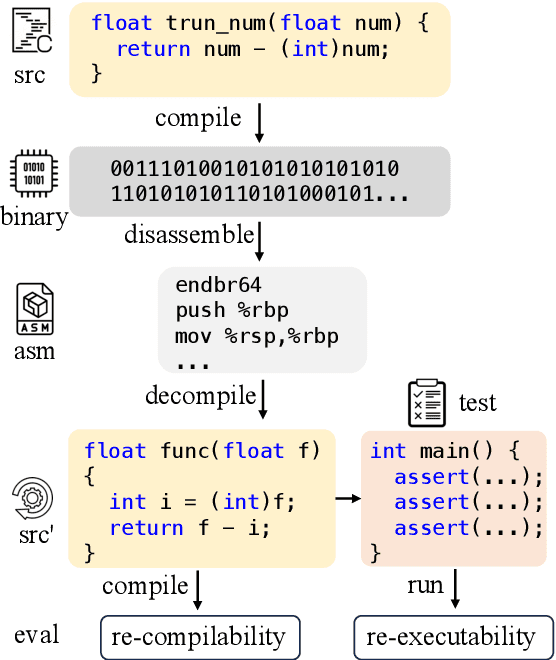

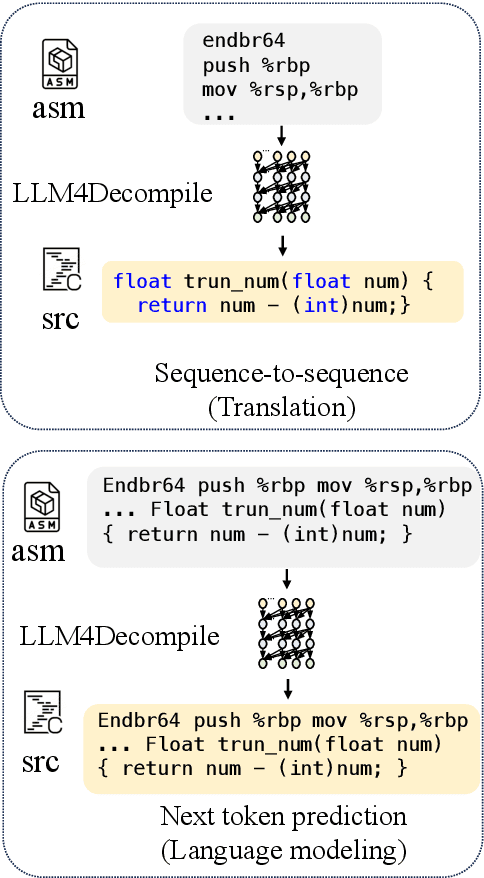

Abstract:Decompilation aims to restore compiled code to human-readable source code, but struggles with details like names and structure. Large language models (LLMs) show promise for programming tasks, motivating their application to decompilation. However, there does not exist any open-source LLM for decompilation. Moreover, existing decompilation evaluation systems mainly consider token-level accuracy and largely ignore code executability, which is the most important feature of any program. Therefore, we release the first open-access decompilation LLMs ranging from 1B to 33B pre-trained on 4 billion tokens of C source code and the corresponding assembly code. The open-source LLMs can serve as baselines for further development in the field. To ensure practical program evaluation, we introduce Decompile-Eval, the first dataset that considers re-compilability and re-executability for decompilation. The benchmark emphasizes the importance of evaluating the decompilation model from the perspective of program semantics. Experiments indicate that our LLM4Decompile has demonstrated the capability to accurately decompile 21% of the assembly code, which achieves a 50% improvement over GPT-4. Our code, dataset, and models are released at https://github.com/albertan017/LLM4Decompile
$1$-Bit SubTHz RIS with Planar Tightly Coupled Dipoles: Beam Shaping and Prototypes
Feb 13, 2024Abstract:In this paper, a proof-of-concept study of a $1$-bit wideband reconfigurable intelligent surface (RIS) comprising planar tightly coupled dipoles (PTCD) is presented. The developed RIS operates at subTHz frequencies and a $3$-dB gain bandwidth of $27.4\%$ with the center frequency at $102$ GHz is shown to be obtainable via full-wave electromagnetic simulations. The binary phase shift offered by each RIS unit element is enabled by changing the polarization of the reflected wave by $180^\circ$. The proposed PTCD-based RIS has a planar configuration with one dielectric layer bonded to a ground plane, and hence, it can be fabricated by using cost-effective printed circuit board (PCB) technology. We analytically calculate the response of the entire designed RIS and showcase that a good agreement between that result and equivalent full-wave simulations is obtained. To efficiently compute the $1$-bit RIS response for different pointing directions, thus, designing a directive beam codebook, we devise a fast approximate beamforming optimization approach, which is compared with time-consuming full-wave simulations. Finally, to prove our concept, we present several passive prototypes with frozen beams for the proposed $1$-bit wideband RIS.
Low-rank Adaptation of Large Language Model Rescoring for Parameter-Efficient Speech Recognition
Sep 26, 2023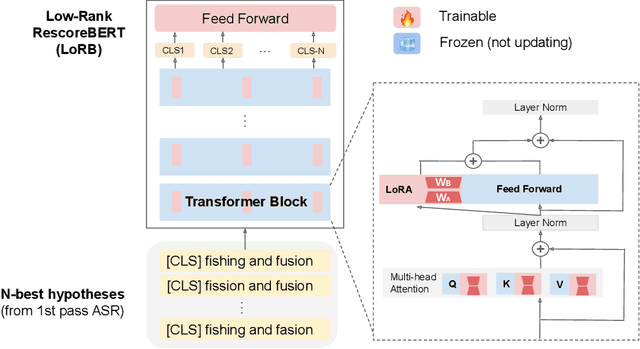

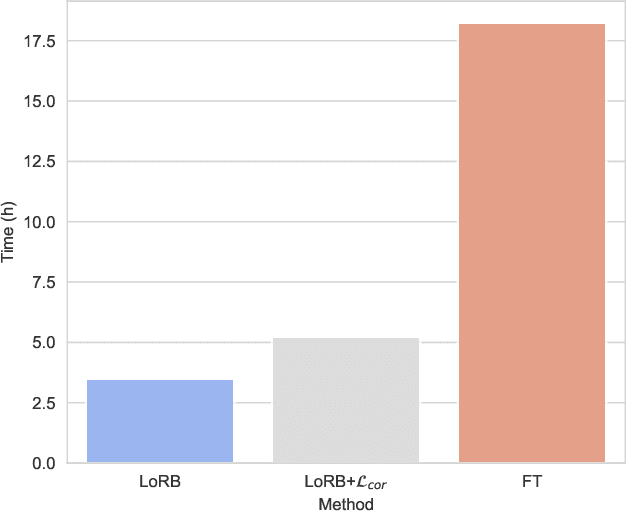

Abstract:We propose a neural language modeling system based on low-rank adaptation (LoRA) for speech recognition output rescoring. Although pretrained language models (LMs) like BERT have shown superior performance in second-pass rescoring, the high computational cost of scaling up the pretraining stage and adapting the pretrained models to specific domains limit their practical use in rescoring. Here we present a method based on low-rank decomposition to train a rescoring BERT model and adapt it to new domains using only a fraction (0.08%) of the pretrained parameters. These inserted matrices are optimized through a discriminative training objective along with a correlation-based regularization loss. The proposed low-rank adaptation Rescore-BERT (LoRB) architecture is evaluated on LibriSpeech and internal datasets with decreased training times by factors between 5.4 and 3.6.
 Add to Chrome
Add to Chrome Add to Firefox
Add to Firefox Add to Edge
Add to Edge